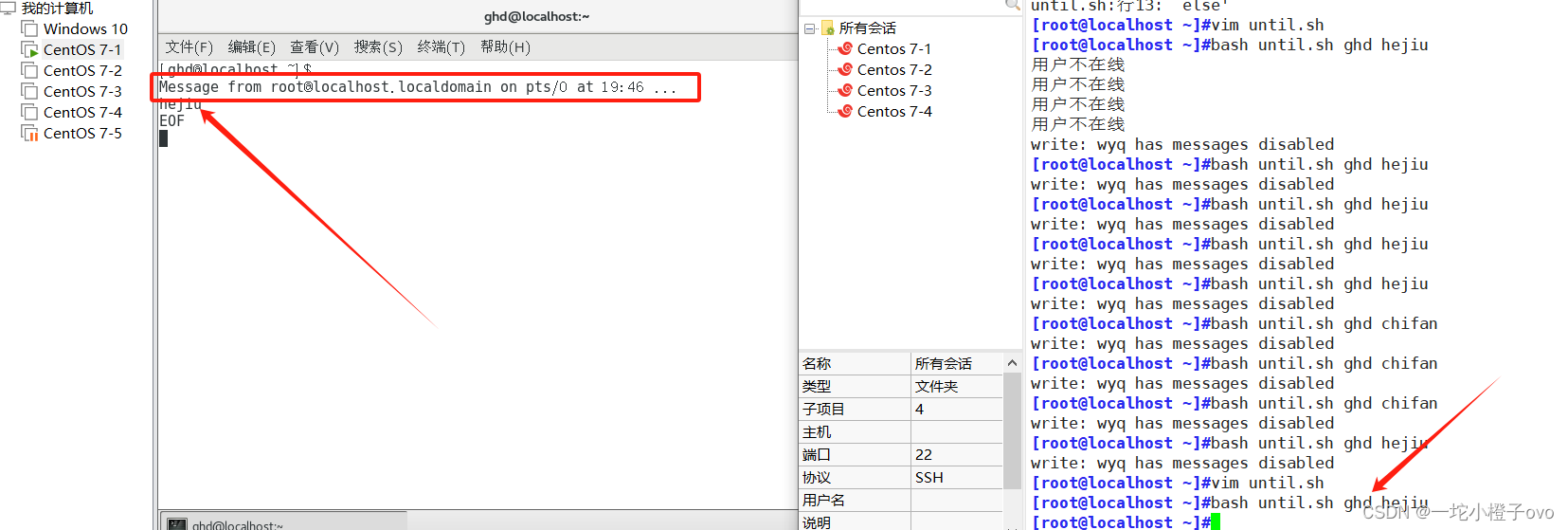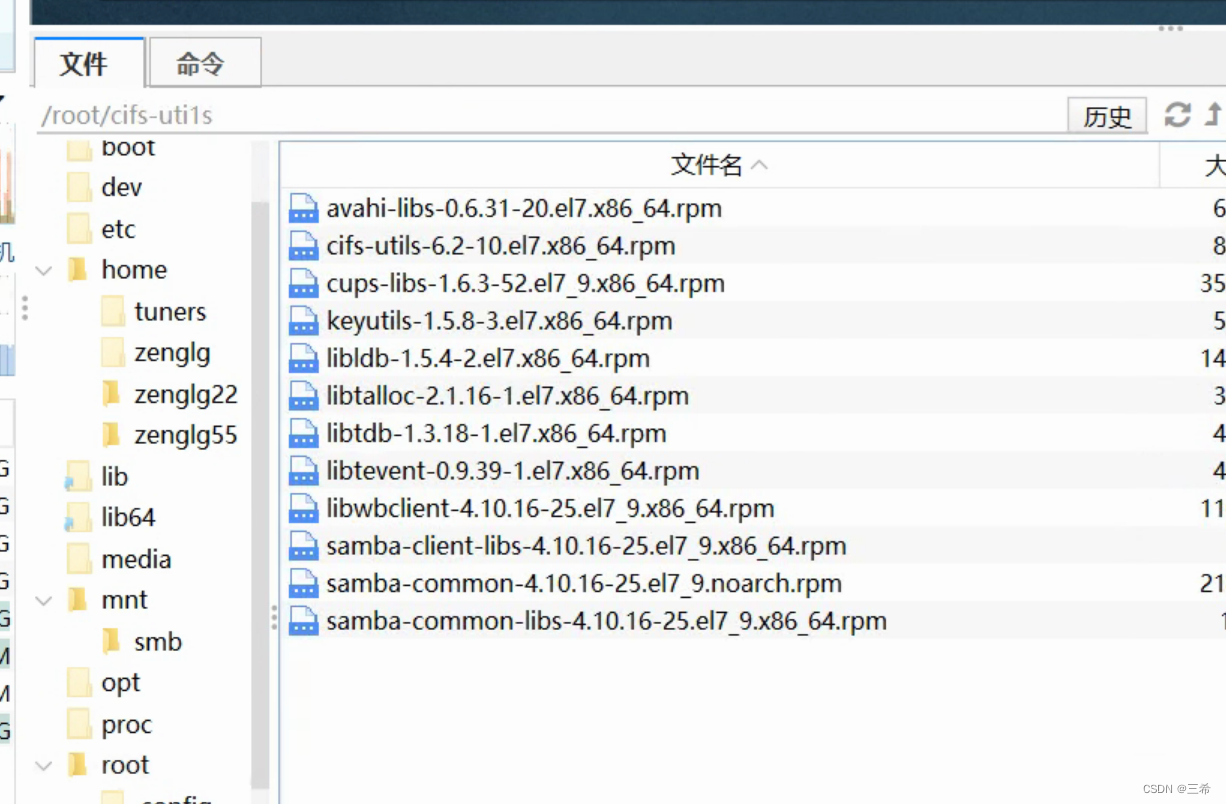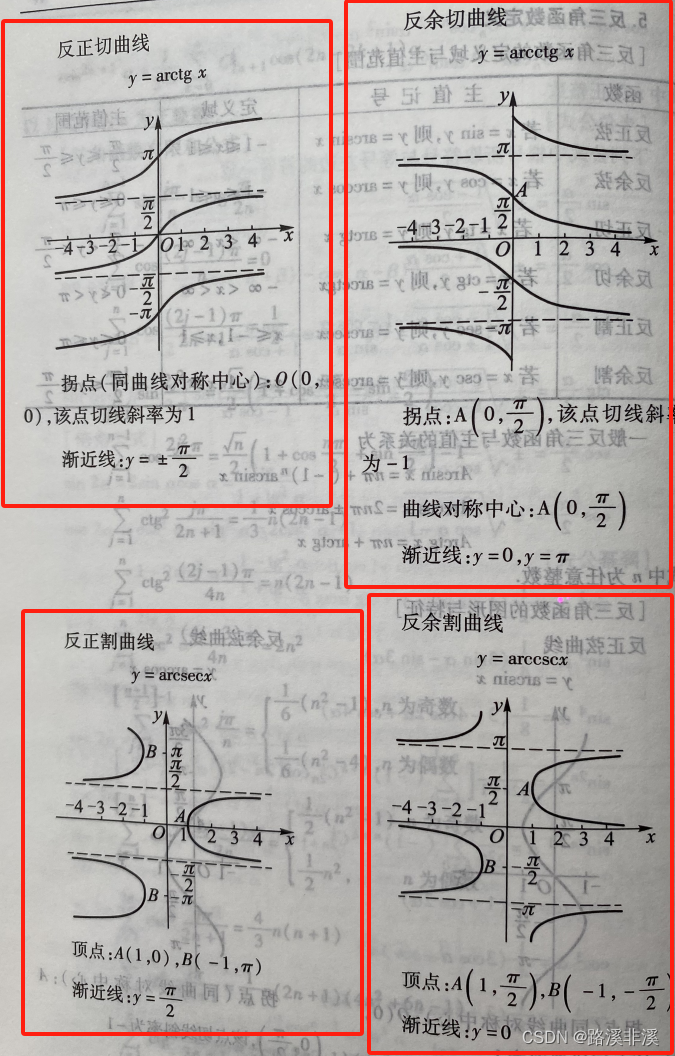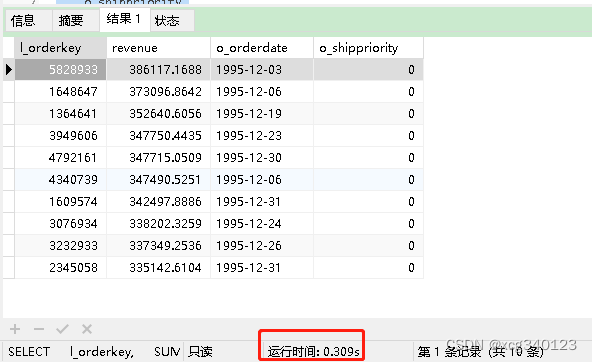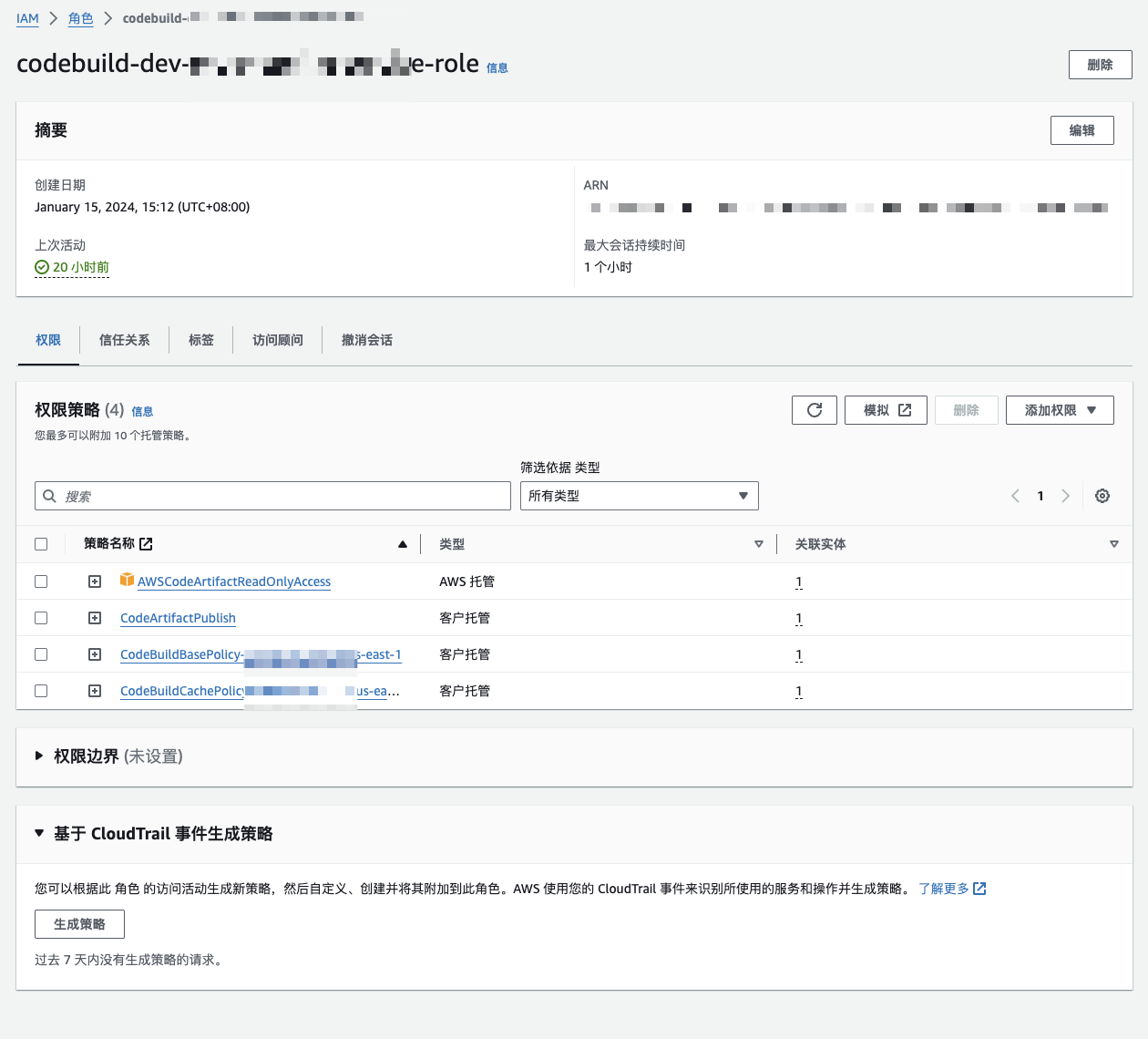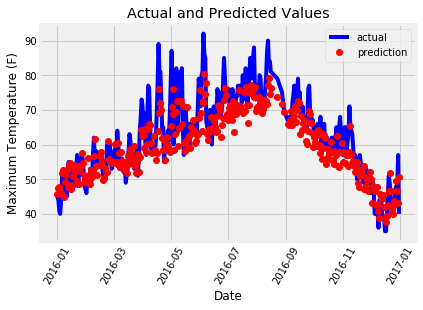一、循环
1.循环的含义
将某代码段重复运行多次,通常有进入循环的条件和退出循环的条件
重复运行次数
- 循环次数事先已知
- 循环次数事先未知
常见的循环的命令:for, while, until
for:已知次数;while,until:已知条件

2.for
2.1语法结构
- 列表循环
- 不带列表循环
- 类C风格的for循环
[root@localhost ~]#help for
for: for 名称 [in 词语 ... ] ; do 命令; done
为列表中的每个成员执行命令。
`for' 循环为列表中的每个成员执行一系列的命令。如果没有
`in WORDS ...;'则假定使用 `in "$@"'。对于 WORDS 中的每
个元素,NAME 被设定为该元素,并且执行 COMMANDS 命令。
退出状态:
返回最后执行的命令的状态。
for ((: for (( 表达式1; 表达式2; 表达式3 )); do 命令; done
算术 for 循环。
等价于
(( EXP1 ))
while (( EXP2 )); do
COMMANDS
(( EXP3 ))
done
EXP1、EXP2 和 EXP3都是算术表达式。如果省略任何表达式,
则等同于使用了估值为1的表达式。
退出状态:
返回最后执行的命令的状态。[root@localhost ~]#for i in a b c d;do echo i=$i;done
i=a
i=b
i=c
i=d
[root@localhost ~]#for i in a b c d;do echo hello world;done
hello world
hello world
hello world
hello world
[root@localhost ~]#for i in `seq 10`;do echo hello world;done
hello world
hello world
hello world
hello world
hello world
hello world
hello world
hello world
hello world
hello world
#for 变量名 in {list}
do
command
done2.2例子
2.2.1列表循环
for 变量名 in {list}
do
command
done[root@localhost ~]#for i in {1..50..2};do echo i=$i;done
#1-50的奇数
i=1
i=3
i=5
i=7
i=9
i=11
i=13
i=15
i=17
i=19
i=21
i=23
i=25
i=27
i=29
i=31
i=33
i=35
i=37
i=39
i=41
i=43
i=45
i=47
i=49
[root@localhost ~]#for i in {2..50..2};do echo i=$i;done
#1-50的偶数
i=2
i=4
i=6
i=8
i=10
i=12
i=14
i=16
i=18
i=20
i=22
i=24
i=26
i=28
i=30
i=32
i=34
i=36
i=38
i=40
i=42
i=44
i=46
i=48
i=50
[root@localhost ~]#for i in {10..1};do echo i=$i;done
#10-1倒序排列
i=10
i=9
i=8
i=7
i=6
i=5
i=4
i=3
i=2
i=1
[root@localhost ~]#for i in $(seq 10);do echo i=$i;done
#1-10正序排列
i=1
i=2
i=3
i=4
i=5
i=6
i=7
i=8
i=9
i=10
[root@localhost ~]#for i in $(seq 10 -1 1);do echo i=$i;done
#10-1的倒序排列
i=10
i=9
i=8
i=7
i=6
i=5
i=4
i=3
i=2
i=1
[root@localhost ~]#for i in $(seq 1 2 10);do echo i=$i;done
#1-10的奇数
i=1
i=3
i=5
i=7
i=9
[root@localhost ~]#for i in $(seq 0 2 10);do echo i=$i;done
#0-10的偶数
i=0
i=2
i=4
i=6
i=8
i=102.2.2不带列表循环
for 变量名
do
command
done[root@localhost ~]#vim hello.sh
#!/bin/bash
for i in {1..10}
do
echo "hello"
done
[root@localhost ~]#bash hello.sh
hello
hello
hello
hello
hello
hello
hello
hello
hello
hello2.2.3类似于C的for语句
for ((expr1;expr2;expr3))
do
command
done
expr1:定义变量并赋初值
expr2:决定是否循环
expr3:决定循环变量如何改变,决定循环什么时候退出sum+=i 等于 sum=sum+i
#需要使用 let 命令
- ++ 自身变量+1
- -- 自身变量-1
- +=5 自身变量+5
- -=5 自身变量-5
- *=5 自身变量*5
- /=5 自身变量/5
- %=5 自身变量%5
[root@localhost ~]#vim qh.sh
#!/bin/bash
for ((i=1;i<=10;i+=2))
do
echo $i
done
[root@localhost ~]#bash qh.sh
1
3
5
7
9求和实验
[root@localhost ~]#vim qh.sh
#!/bin/bash
sum=0
for ((i=0;i<=100;i++))
do
sum=$[i+sum]
done
echo "求和结果为 $sum"
[root@localhost ~]#bash qh.sh
求和结果为 5050[root@localhost ~]#vim qh1.sh
#!/bin/bash
sum=0
for i in `seq 10`
do
sum=$[i+sum]
done
echo "求和结果为 $sum"
[root@localhost ~]#bash qh1.sh
求和结果为 55
九九乘法表
[root@localhost ~]#vim 99cfb.sh
#i是列 j是行
#!/bin/bash
for ((i=1;i<=9;i++))
do
for((j=1;j<=i;j++))
do
echo -e "${i}x${j}=$[i*j] \t\c"
done
echo
done
[root@localhost ~]#bash 99cfb.sh
1x1=1
2x1=2 2x2=4
3x1=3 3x2=6 3x3=9
4x1=4 4x2=8 4x3=12 4x4=16
5x1=5 5x2=10 5x3=15 5x4=20 5x5=25
6x1=6 6x2=12 6x3=18 6x4=24 6x5=30 6x6=36
7x1=7 7x2=14 7x3=21 7x4=28 7x5=35 7x6=42 7x7=49
8x1=8 8x2=16 8x3=24 8x4=32 8x5=40 8x6=48 8x7=56 8x8=64
9x1=9 9x2=18 9x3=27 9x4=36 9x5=45 9x6=54 9x7=63 9x8=72 9x9=81回收站
[root@localhost ~]#vim hsz.sh
#!/bin/bash
WARNING_COLOR="echo -e \E[1;36m"
END="\E[0m"
DIR=/tmp/`date +%F_%H-%M-%S`
mkdir $DIR
mv $* $DIR
${WARNING_COLOR} Move $* to $DIR $END
[root@localhost ~]#chmod +x hsz.sh
#给回收站加一个执行权限
[root@localhost ~]#alias rm=hsz.sh
#定义别名rm为hsz.sh
[root@localhost ~]#touch 123.txt
[root@localhost ~]#ls
123.txt hello.sh qh.sh xxgjx.sh
99cfb.sh hh.sh scandisk.sh yunsuan.sh
99.sh h.sh score1.sh 公共
adduser.sh hsz.sh score2.sh 模板
anaconda-ks.cfg initial-setup-ks.cfg score3.sh 视频
az.sh jttl.sh score.sh 图片
bjc1.sh ljf.sh tbj.sh 文档
bjc.sh menu.sh test1.sh 下载
case.sh mv.sh test.sh 音乐
fenshu.sh ping1.sh webmin-2.100-1.noarch.rpm 桌面
h1.sh ping.sh xtuser.sh
[root@localhost ~]#bash hsz.sh 123.txt
#使用回收站
Move 123.txt to /opt/2024-01-25_16-45-15
#回收站的脚本运行 移动123.txt文件导/opt/下并建立名为2024年1月25日16时45分15秒的文件夹
[root@localhost ~]#ls /opt/
#去查看/opt文件夹下 是否有回收站的文件
2024-01-25_16-45-15 hostonline.txt off.txt
hostoffline.txt name.txt on.txt
[root@localhost ~]#cd /opt/2024-01-25_16-45-15/
[root@localhost 2024-01-25_16-45-15]#ls
123.txt2.3实验操作
2.3.1将目录文件夹下的.sh结尾的文件改为.txt结尾
[root@localhost ~]#cd /opt
[root@localhost opt]#ls
[root@localhost opt]#touch {1..10}.sh
[root@localhost opt]#ls
10.sh 1.sh 2.sh 3.sh 4.sh 5.sh 6.sh 7.sh 8.sh 9.sh
[root@localhost opt]#cd
[root@localhost ~]#vim mv.sh
#/bin/bash
for i in `ls /opt`
do
name=`echo ${i}|cut -d "." -f1`
mv /opt/${i} /opt/${name}.txt
done
[root@localhost ~]#bash mv.sh
[root@localhost ~]#ls /opt
10.txt 1.txt 2.txt 3.txt 4.txt 5.txt 6.txt 7.txt 8.txt 9.txt2.3.2100以内数字的求和结果
[root@localhost ~]#vim ljf.sh
#!/bin/bash
sum=0
for i in {1..100}
do
sum=$[i+sum]
done
echo "求和结果为 $sum"
#求奇数和
sum=0
for i in {1..100..2}
do
let sum+=$i
done
echo "奇数和为$sum"
#求偶数和
sum=0
for i in {0..100..2}
do
let sum=$[i+sum]
done
echo "偶数和为$sum"
# i=1 sum=0 sum1=1+0=1
# i=2 sum=1 sum2=1+2=3
# i=3 sum=3 sum3=3+3=6
# i=4 sum=6 sum4=4+6=10
[root@localhost ~]#bash ljf.sh
求和结果为 5050
奇数和为2500
偶数和为25502.3.3批量添加用户
- 用户名存放在users.txt文件中,每行一个
- 初始密码均设置为123123
- 验证脚本
[root@localhost opt]#vim name.txt
wyq
xyl
cxk
[root@localhost opt]#cd
[root@localhost ~]#vim adduser.sh
#!/bin/bash
for i in `cat /opt/name.txt`
do
id $i &>>/dev/null
if [ $? -eq 0 ]
then
echo ${i}"用户已存在"
else
useradd $i
echo 123123 | passwd --stdin $i &>>/dev/null
fi
done
[root@localhost ~]#bash adduser.sh
正在创建信箱文件: 文件已存在
正在创建信箱文件: 文件已存在
cxk用户已存在
[root@localhost ~]#bash adduser.sh
wyq用户已存在
xyl用户已存在
cxk用户已存在
[root@localhost ~]#vim /opt/name.txt
wyq
xyl
cxk
wsc
[root@localhost ~]#bash adduser.sh
wyq用户已存在
xyl用户已存在
cxk用户已存在
正在创建信箱文件: 文件已存在
[root@localhost ~]#bash adduser.sh
wyq用户已存在
xyl用户已存在
cxk用户已存在
wsc用户已存在
2.3.4验证网段内的主机网络是否畅通
方法一
[root@localhost ~]#vim ping.sh
#!/bin/bash
for i in {1..254}
do
{
ping -c2 -W2 192.168.241.$i &>/dev/null && echo "$i is online" >> /opt/hostonline.txt ||echo "$i is offline" >> /opt/hostoffline.txt
} &
done
[root@localhost ~]#bash ping.sh
[root@localhost ~]#ls /opt
hostonline.txt name.txt
#此时正在后台执行ping offline还未ping
[root@localhost ~]#ls /opt
hostoffline.txt hostonline.txt name.txt
#此时online 和 offline 都已完成ping
[root@localhost ~]#cat /opt/hostonline.txt
1 is online
11 is online
2 is online
[root@localhost ~]#cat /opt/hostoffline.txt
5 is offline
3 is offline
8 is offline
9 is offline
12 is offline
14 is offline
16 is offline
30 is offline
29 is offline
25 is offline
27 is offline
19 is offline
21 is offline
23 is offline
33 is offline
37 is offline
34 is offline
49 is offline
45 is offline
51 is offline
43 is offline
39 is offline
47 is offline
54 is offline
41 is offline
52 is offline
67 is offline
57 is offline
59 is offline
65 is offline
6 is offline
61 is offline
113 is offline
68 is offline
7 is offline
82 is offline
4 is offline
99 is offline
86 is offline
70 is offline
111 is offline
60 is offline
79 is offline
95 is offline
76 is offline
93 is offline
106 is offline
73 is offline
101 is offline
88 is offline
85 is offline
71 is offline
90 is offline
81 is offline
38 is offline
75 is offline
69 is offline
44 is offline
28 is offline
10 is offline
87 is offline
50 is offline
53 is offline
77 is offline
32 is offline
80 is offline
63 is offline
66 is offline
83 is offline
72 is offline
35 is offline
104 is offline
89 is offline
91 is offline
110 is offline
108 is offline
92 is offline
31 is offline
97 is offline
100 is offline
22 is offline
98 is offline
48 is offline
102 is offline
74 is offline
96 is offline
94 is offline
103 is offline
64 is offline
13 is offline
105 is offline
15 is offline
124 is offline
24 is offline
55 is offline
17 is offline
112 is offline
18 is offline
131 is offline
20 is offline
126 is offline
36 is offline
109 is offline
107 is offline
84 is offline
56 is offline
114 is offline
40 is offline
118 is offline
58 is offline
46 is offline
62 is offline
119 is offline
120 is offline
78 is offline
122 is offline
42 is offline
132 is offline
115 is offline
116 is offline
138 is offline
140 is offline
117 is offline
135 is offline
121 is offline
231 is offline
128 is offline
207 is offline
143 is offline
212 is offline
137 is offline
227 is offline
245 is offline
203 is offline
229 is offline
145 is offline
149 is offline
193 is offline
168 is offline
146 is offline
169 is offline
154 is offline
222 is offline
205 is offline
233 is offline
175 is offline
151 is offline
165 is offline
156 is offline
180 is offline
167 is offline
161 is offline
238 is offline
157 is offline
163 is offline
189 is offline
225 is offline
184 is offline
208 is offline
159 is offline
198 is offline
171 is offline
240 is offline
178 is offline
241 is offline
123 is offline
176 is offline
179 is offline
142 is offline
141 is offline
177 is offline
148 is offline
164 is offline
170 is offline
210 is offline
220 is offline
181 is offline
162 is offline
125 is offline
183 is offline
133 is offline
186 is offline
26 is offline
155 is offline
188 is offline
190 is offline
166 is offline
192 is offline
187 is offline
223 is offline
194 is offline
199 is offline
196 is offline
236 is offline
197 is offline
200 is offline
144 is offline
206 is offline
216 is offline
201 is offline
230 is offline
202 is offline
185 is offline
211 is offline
243 is offline
191 is offline
204 is offline
134 is offline
226 is offline
228 is offline
152 is offline
147 is offline
221 is offline
237 is offline
129 is offline
160 is offline
209 is offline
182 is offline
195 is offline
217 is offline
218 is offline
214 is offline
219 is offline
139 is offline
246 is offline
127 is offline
234 is offline
172 is offline
239 is offline
136 is offline
235 is offline
158 is offline
232 is offline
150 is offline
224 is offline
153 is offline
244 is offline
174 is offline
213 is offline
215 is offline
242 is offline
173 is offline
130 is offline
247 is offline
251 is offline
250 is offline
254 is offline
252 is offline
253 is offline
248 is offline
249 is offline方法二
[root@localhost ~]#vim ping1.sh
#!/bin/bash
{
for i in {1..254}
do
ping -c2 -W2 192.168.91.$i &>/dev/null
if [ $? -eq 0 ]
then
echo "host is online" >>/opt/on.txt
else
echo "host is offline" >>/opt/off.txt
fi
done
}&
[root@localhost ~]#bash ping1.sh
[root@localhost ~]#ls /opt
hostoffline.txt hostonline.txt name.txt on.txt
[root@localhost ~]#ls /opt
hostoffline.txt hostonline.txt name.txt on.txt
[root@localhost ~]#ls /opt
hostoffline.txt hostonline.txt name.txt off.txt on.txt
#此方法后台执行比较慢 建议使用第一种方法
2.3.5九九乘法表
我们要知道九九乘法表是直角三角形 形状的
首先 要知道如何打印横向和纵向的*
[root@localhost ~]#for i in {1..9};do echo "*";done
*
*
*
*
*
*
*
*
*
[root@localhost ~]#for i in {1..9};do echo -e "*\c";done
*********[root@localhost ~]#如何打印矩形
[root@localhost ~]#vim 99.sh
#!/bin/bash
#j 行数 i 列数
for j in {1..9}
do
for i in `seq 9`
do
echo -e "*\c"
done
echo
done
[root@localhost ~]#bash 99.sh
*********
*********
*********
*********
*********
*********
*********
*********
*********然后我们探讨如何打印出直角三角形
[root@localhost ~]#vim 99.sh
#!/bin/bash
#j 行数 i 列数
for j in {1..9}
do
for i in `seq $j`
do
echo -e "*\c"
done
echo
done
[root@localhost ~]#bash 99.sh
*
**
***
****
*****
******
*******
********
*********
然后我们可以打印出算式
[root@localhost ~]#vim 99.sh
#!/bin/bash
#j 行数 i 列数
for j in {1..9}
do
for i in `seq $j`
do
echo -e "${i}x${j} \c"
done
echo
done
[root@localhost ~]#bash 99.sh
1x1
1x2 2x2
1x3 2x3 3x3
1x4 2x4 3x4 4x4
1x5 2x5 3x5 4x5 5x5
1x6 2x6 3x6 4x6 5x6 6x6
1x7 2x7 3x7 4x7 5x7 6x7 7x7
1x8 2x8 3x8 4x8 5x8 6x8 7x8 8x8
1x9 2x9 3x9 4x9 5x9 6x9 7x9 8x9 9x9最后我们可以将运算结果添加进去
[root@localhost ~]#vim 99.sh
#!/bin/bash
#j 行数 i 列数
for j in {1..9}
do
for i in `seq $j`
do
echo -e "${i}x${j}=$[i*j] \c"
done
echo
done
[root@localhost ~]#bash 99.sh
1x1=1
1x2=2 2x2=4
1x3=3 2x3=6 3x3=9
1x4=4 2x4=8 3x4=12 4x4=16
1x5=5 2x5=10 3x5=15 4x5=20 5x5=25
1x6=6 2x6=12 3x6=18 4x6=24 5x6=30 6x6=36
1x7=7 2x7=14 3x7=21 4x7=28 5x7=35 6x7=42 7x7=49
1x8=8 2x8=16 3x8=24 4x8=32 5x8=40 6x8=48 7x8=56 8x8=64
1x9=9 2x9=18 3x9=27 4x9=36 5x9=45 6x9=54 7x9=63 8x9=72 9x9=81我们发现有点不太美观 可以调整一下echo -e \t
[root@localhost ~]#vim 99.sh
#!/bin/bash
#j 行数 i 列数
for j in {1..9}
do
for i in `seq $j`
do
echo -e "${i}x${j}=$[i*j] \t\c"
done
echo
done
[root@localhost ~]#bash 99.sh
1x1=1
1x2=2 2x2=4
1x3=3 2x3=6 3x3=9
1x4=4 2x4=8 3x4=12 4x4=16
1x5=5 2x5=10 3x5=15 4x5=20 5x5=25
1x6=6 2x6=12 3x6=18 4x6=24 5x6=30 6x6=36
1x7=7 2x7=14 3x7=21 4x7=28 5x7=35 6x7=42 7x7=49
1x8=8 2x8=16 3x8=24 4x8=32 5x8=40 6x8=48 7x8=56 8x8=64
1x9=9 2x9=18 3x9=27 4x9=36 5x9=45 6x9=54 7x9=63 8x9=72 9x9=81如果我们再美观一点 搞点颜色看看

#!/bin/bash
#j 行数 i 列数
for j in {1..9}
do
for i in `seq $j`
do
echo -e "\E[1;35m"${i}x${j}=$[i*j]"\E[0m\t\c"
done
echo
done
如果想随机颜色查看九九乘法表
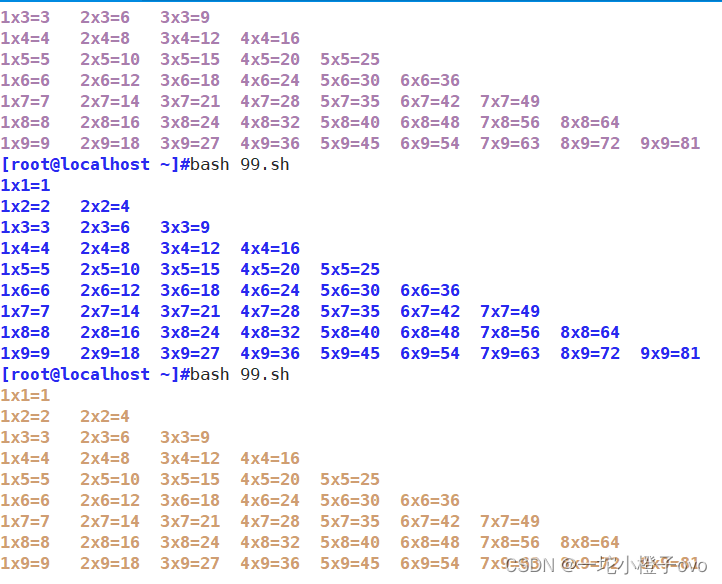
#/bin/bash
#j 行数 i 列数
R=$[RANDOM%7+31]
for j in {1..9}
do
for i in `seq $j`
do
echo -e "\E[1;$[R]m"${i}x${j}=$[i*j]"\E[0m\t\c"
done
echo
done倒序九九乘法表
[root@localhost ~]#vim dx99.sh
#!/bin/bash
for j in {1..9}
do
for i in `seq $[10-$j]`
do
echo -ne " ${i}x`echo $[10-j]`=$[(10 -j)*i]\t"
done
echo
done
[root@localhost ~]#bash dx99.sh
1x9=9 2x9=18 3x9=27 4x9=36 5x9=45 6x9=54 7x9=63 8x9=72 9x9=81
1x8=8 2x8=16 3x8=24 4x8=32 5x8=40 6x8=48 7x8=56 8x8=64
1x7=7 2x7=14 3x7=21 4x7=28 5x7=35 6x7=42 7x7=49
1x6=6 2x6=12 3x6=18 4x6=24 5x6=30 6x6=36
1x5=5 2x5=10 3x5=15 4x5=20 5x5=25
1x4=4 2x4=8 3x4=12 4x4=16
1x3=3 2x3=6 3x3=9
1x2=2 2x2=4
1x1=13.while
相对于for,需要知道循环次数;我们只知道停止条件,不知道次数,就需要使用while,直到直达条件
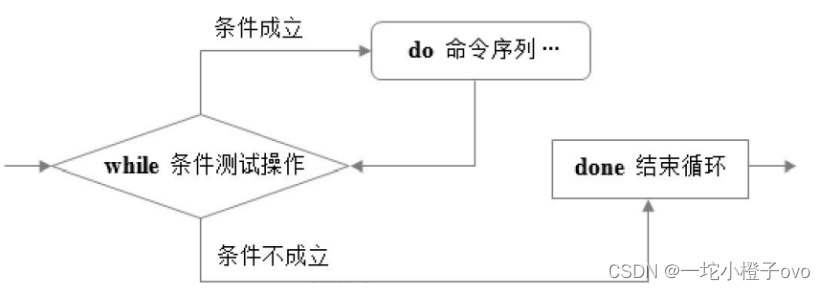
3.1语法
while 条件判断
do
done3.2死循环
while死循环1.2.3
1.while [ 1 -eq 1 ]
#写一个永远为真的表达式,1等于1这个条件永远为真,所以这个脚本会一直循环下去
do
command
done
2.while true
do
command
done
3.while :
do
command
done
[root@localhost ~]#help :
:: :
空的命令。
没有效果; 此命令不做任何操作。
退出状态:
总是成功。
[root@localhost ~]#help true
true: 真
返回一个成功结果。
退出状态:
总是成功while循环一般用于有条件判断的循环,若判断条件为真,则进入循环,当条件为假就跳出循环
3.3实验
3.3.1累加求和
[root@localhost ~]#vim ljqh.sh
#!/bin/bash
i=0
sum=0
while [ $i -le 100 ]
do
sum=$[i+sum]
let i++
#每次执行一次循环 i自加1
done
echo $sum
[root@localhost ~]#bash ljqh.sh
50503.3.2批量添加用户
[root@localhost ~]#vim useradd.sh
#!/bin/bash
cxk=1
while [ $cxk -le 20 ]
do
useradd stu$cxk
echo "123123"|passwd --stdin stu$cxk &>>/dev/null
let cxk++
done
[root@localhost ~]#bash useradd.sh
[root@localhost ~]#cat /etc/passwd|tail -n 25
apache:x:48:48:Apache:/usr/share/httpd:/sbin/nologin
cxk:x:1001:1001::/home/cxk:/bin/bash
wyq:x:1002:1002::/home/wyq:/bin/bash
xyl:x:1003:1003::/home/xyl:/bin/bash
wsc:x:1004:1004::/home/wsc:/bin/bash
stu1:x:1005:1005::/home/stu1:/bin/bash
stu2:x:1006:1006::/home/stu2:/bin/bash
stu3:x:1007:1007::/home/stu3:/bin/bash
stu4:x:1008:1008::/home/stu4:/bin/bash
stu5:x:1009:1009::/home/stu5:/bin/bash
stu6:x:1010:1010::/home/stu6:/bin/bash
stu7:x:1011:1011::/home/stu7:/bin/bash
stu8:x:1012:1012::/home/stu8:/bin/bash
stu9:x:1013:1013::/home/stu9:/bin/bash
stu10:x:1014:1014::/home/stu10:/bin/bash
stu11:x:1015:1015::/home/stu11:/bin/bash
stu12:x:1016:1016::/home/stu12:/bin/bash
stu13:x:1017:1017::/home/stu13:/bin/bash
stu14:x:1018:1018::/home/stu14:/bin/bash
stu15:x:1019:1019::/home/stu15:/bin/bash
stu16:x:1020:1020::/home/stu16:/bin/bash
stu17:x:1021:1021::/home/stu17:/bin/bash
stu18:x:1022:1022::/home/stu18:/bin/bash
stu19:x:1023:1023::/home/stu19:/bin/bash
stu20:x:1024:1024::/home/stu20:/bin/bash3.3.3批量删除用户
[root@localhost ~]#vim userdel.sh
#!/bin/bash
cxk=1
while [ $cxk -le 20 ]
do
userdel stu$cxk
let cxk++
done
[root@localhost ~]#bash userdel.sh
[root@localhost ~]#cat /etc/passwd|tail -n 25
rtkit:x:172:172:RealtimeKit:/proc:/sbin/nologin
pulse:x:171:171:PulseAudio System Daemon:/var/run/pulse:/sbin/nologin
chrony:x:995:991::/var/lib/chrony:/sbin/nologin
rpcuser:x:29:29:RPC Service User:/var/lib/nfs:/sbin/nologin
nfsnobody:x:65534:65534:Anonymous NFS User:/var/lib/nfs:/sbin/nologin
ntp:x:38:38::/etc/ntp:/sbin/nologin
tss:x:59:59:Account used by the trousers package to sandbox the tcsd daemon:/dev/null:/sbin/nologin
usbmuxd:x:113:113:usbmuxd user:/:/sbin/nologin
geoclue:x:994:989:User for geoclue:/var/lib/geoclue:/sbin/nologin
qemu:x:107:107:qemu user:/:/sbin/nologin
radvd:x:75:75:radvd user:/:/sbin/nologin
setroubleshoot:x:993:988::/var/lib/setroubleshoot:/sbin/nologin
sssd:x:992:987:User for sssd:/:/sbin/nologin
gdm:x:42:42::/var/lib/gdm:/sbin/nologin
gnome-initial-setup:x:991:986::/run/gnome-initial-setup/:/sbin/nologin
sshd:x:74:74:Privilege-separated SSH:/var/empty/sshd:/sbin/nologin
avahi:x:70:70:Avahi mDNS/DNS-SD Stack:/var/run/avahi-daemon:/sbin/nologin
postfix:x:89:89::/var/spool/postfix:/sbin/nologin
tcpdump:x:72:72::/:/sbin/nologin
ghd:x:1000:1000:ghd:/home/ghd:/bin/bash
apache:x:48:48:Apache:/usr/share/httpd:/sbin/nologin
cxk:x:1001:1001::/home/cxk:/bin/bash
wyq:x:1002:1002::/home/wyq:/bin/bash
xyl:x:1003:1003::/home/xyl:/bin/bash
wsc:x:1004:1004::/home/wsc:/bin/bash3.3.4盲猜商品价格
[root@localhost ~]#vim caicai.sh
#!/bin/bash
p=`echo $[RANDOM%1000+1]`
time=0
while :
do
read -p "请输入商品的价格(1-1000):" h
let time++
if [ $p -eq $h ]
then
echo "恭喜你猜对了,商品价格是${h};您一共猜了$time次"
exit
#跳出循环
elif [ $p -gt $h -a $h -le 1000 -a $h -gt 0 ]
then
echo "您猜的价格过低,请往高了猜"
elif [ $p -lt $h -a $h -le 1000 -a $h -gt 0 ]
then
echo "您猜的价格过高"
else
echo "输入有误,请重新输入"
fi
done
[root@localhost ~]#bash caicai.sh
请输入商品的价格(1-1000):10000
输入有误,请重新输入
请输入商品的价格(1-1000):1000
您猜的价格过高
请输入商品的价格(1-1000):500
您猜的价格过低,请往高了猜
请输入商品的价格(1-1000):600
您猜的价格过低,请往高了猜
请输入商品的价格(1-1000):700
您猜的价格过高
请输入商品的价格(1-1000):650
您猜的价格过高
请输入商品的价格(1-1000):630
您猜的价格过低,请往高了猜
请输入商品的价格(1-1000):640
您猜的价格过低,请往高了猜
请输入商品的价格(1-1000):645
恭喜你猜对了,商品价格是645;您一共猜了9次4.跳出循环
- break跳出单个循环 break n 数字数字是几代表跳出n层循环
- continue终止某次循环中的命令,但是不会完全终止命令
- exit 直接退出脚本
4.1break——跳出单个循环
[root@localhost ~]#vim break.sh
#!/bin/bash
for j in {1..5}
do
for i in {1..10}
do
echo i=$i
done
echo "-------------------------------"
done
[root@localhost ~]#bash break.sh
i=1
i=2
i=3
i=4
i=5
i=6
i=7
i=8
i=9
i=10
-------------------------------
i=1
i=2
i=3
i=4
i=5
i=6
i=7
i=8
i=9
i=10
-------------------------------
i=1
i=2
i=3
i=4
i=5
i=6
i=7
i=8
i=9
i=10
-------------------------------
i=1
i=2
i=3
i=4
i=5
i=6
i=7
i=8
i=9
i=10
-------------------------------
i=1
i=2
i=3
i=4
i=5
i=6
i=7
i=8
i=9
i=10
-------------------------------[root@localhost ~]#vim break2.sh
#!/bin/bash
for i in {1..10}
do
if [ $i -eq 5 ]
then break 2
fi
echo i=$i
done
[root@localhost ~]#bash break2.sh
i=1
i=2
i=3
i=4break 截止到当前为止就结束;
break默认为1;
break n代表跳出几次循环。
4.2Continue——跳出本次循环 只结束某次循环
[root@localhost ~]#vim continue.sh
#!/bin/bash
for j in {1.5}
do
for i in {1..10}
do
if [ $i -eq 5 ]
then
continue
fi
echo i=$i
done
echo "-----------------"
done
[root@localhost ~]#bash continue.sh
i=1
i=2
i=3
i=4
i=6
i=7
i=8
i=9
i=10
-----------------
4.3exit——跳出整个脚本
[root@localhost ~]#vim exit.sh
#!/bin/bash
for i in {1..10}
do
if [ $i -eq 5 ]
then
echo i=$i
fi
echo "hello"
done
[root@localhost ~]#bash exit.sh
hello
hello
hello
hello
i=5
hello
hello
hello
hello
hello
hello
[root@localhost ~]#vim exit.sh
#!/bin/bash
for i in {1..10}
do
if [ $i -eq 5 ]
then
echo i=$i
fi
echo "hello"
exit
done
[root@localhost ~]#bash exit.sh
hello5.截取网卡流量——好累啊 学不动了
[root@localhost opt]#ifconfig ens33
ens33: flags=4163<UP,BROADCAST,RUNNING,MULTICAST> mtu 1500
inet 192.168.241.11 netmask 255.255.255.0 broadcast 192.168.241.255
inet6 fe80::de6f:32c8:5a64:a6b2 prefixlen 64 scopeid 0x20<link>
ether 00:0c:29:51:4b:b5 txqueuelen 1000 (Ethernet)
RX packets 31858 bytes 2477287 (2.3 MiB)
RX errors 0 dropped 0 overruns 0 frame 0
TX packets 19352 bytes 2764635 (2.6 MiB)
TX errors 0 dropped 0 overruns 0 carrier 0 collisions 0
[root@localhost opt]#ifconfig ens33
ens33: flags=4163<UP,BROADCAST,RUNNING,MULTICAST> mtu 1500
inet 192.168.241.11 netmask 255.255.255.0 broadcast 192.168.241.255
inet6 fe80::de6f:32c8:5a64:a6b2 prefixlen 64 scopeid 0x20<link>
ether 00:0c:29:51:4b:b5 txqueuelen 1000 (Ethernet)
RX packets 31862 bytes 2477595 (2.3 MiB)
RX errors 0 dropped 0 overruns 0 frame 0
TX packets 19356 bytes 2765571 (2.6 MiB)
TX errors 0 dropped 0 overruns 0 carrier 0 collisions 0
[root@localhost opt]#ifconfig ens33|grep "RX pa"
RX packets 31957 bytes 2484729 (2.3 MiB)
[root@localhost opt]#ifconfig ens33|grep "RX pa"|awk '{print $3}'
32017
[root@localhost opt]#ifconfig ens33|grep "RX pa"|awk '{print $3}'
32025因为网卡流量是不断变化的 所以每次截取的流量不同
6.until——当不成立时才会执行
6.1求和
[root@localhost ~]#vim until.sh
#!/bin/bash
sum=0
i=0
until [ $i -gt 100 ]
do
sum=$[i+sum]
let i++
done
echo $sum
[root@localhost ~]#bash until.sh
50506.2约吗
- 为指定用户发送在线消息
- 若用户不在线(未登录系统),则每10分钟试一次,直至用户登录系统后再发送消息
- 用户名与消息通过位置参数传递给脚本
[root@localhost ~]#vim until.sh
#!/bin/bash
#判断输入的参数是否满足条件
if [ $# -lt 2 ] &>/dev/null
then
echo "位置参数不足,需要在脚本后面添加用户名和发送消息"
exit 1
fi
#判断用户是否存在
if grep -q "^$1:" /etc/passwd
then :
# :表示打印一个空行 否则该命令有错误
else
echo -e "用户不存在\t"
exit 1
fi
#判断用户是否在线
until who |grep $1 &>/dev/null
do
echo "用户不在线"
sleep 5
done
echo $2 | write ghd
[root@localhost ~]#bash until.sh ghd hejiu
#用户未登录会每五秒提示“用户不在线”
用户不在线
用户不在线
用户不在线
用户不在线
write: wyq has messages disabled
[root@localhost ~]#bash until.sh ghd hejiu
#信息会显示在配置文件中的客户终端